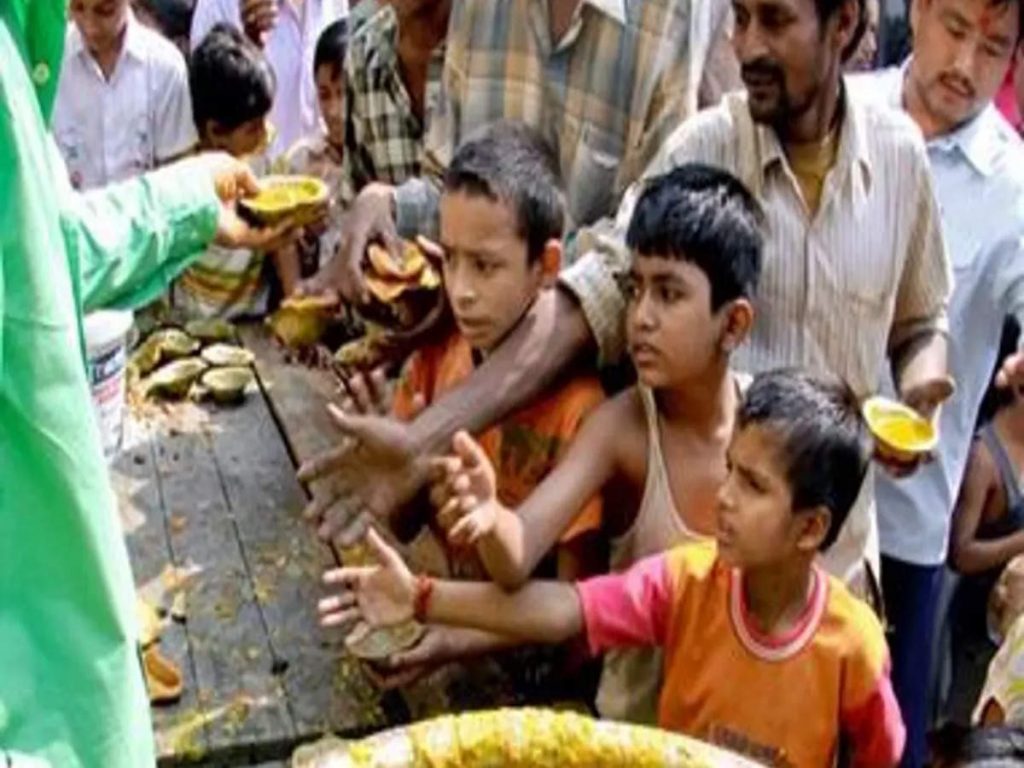Prof SN Mishra
The Millennium Development Goal 4 had set a target of halving the percentage of population suffering from chronic hunger. By the end of 2015, this target was met by 73 countries (including India). Yet 800 million still did not have enough to eat, including 270 million in India. The Sustainable Development Goals (2015-2030) have set an ambitious target of Zero Hunger based on a utopian premise that freedom and fundamental right to food equally belongs to all humanity. The World Hunger Report (2021) brings out that a toxic cocktail of COVID-19, climate crisis and protracted conflicts have cast a shadow on the fight against hunger. India sadly ranks 101 among 116 countries with a score of 27.5. The GHI score is calculated on four indicators, undernourishment, wasting and stunting of children and child mortality. The report has suggested four priorities, namely an agile approach based on understanding of local context, commitment to working in partnerships to bring together local actors, national government and international organisations, integrate ways of working along human-development-peace nexus and need based multi-year financing.
The report brings out how COVID-19 has affected healthcare services, immunisation, treatment of malnutrition and antenatal care. About 60-70% disruptions in immunisation services have been reported. While the effect of the pandemic on child nutrition has not yet been comprehensively measured, estimates suggest sizeable impact. The report estimates an addition of 9.3 million children are wasted and 2.6 million stunted.
The GHI report highlights the pernicious impact of ‘hidden hunger’, which affects nearly 2 billion people or 30%of the global population. For instance, deficiency of iodine causes brain damage in newborns, retards mental capacity and results in goiter. Close to 1.8 billion are deficient in iodine. Deficiency of iron causes anaemia, impairment of motor and low birth weight. Around 1.6 billion people suffer from this deficiency. Lack of adequate vitamin A results in visual impairment and blindness and 190 million children suffer from this deficiency. Lack of adequate intake of zinc causes weak immune system, frequent infection and stunting. Close to 1.2 billion people suffer from this deficiency.
The UNICEF has calculated the economic cost of all forms of micro nutrients to the order of 2% -7% of GDP. In the case of India, the loss is estimated at 1% of GDP. As per Copenhagen Consensus, vitamin A, zinc, fortification of food with iron and iodine, and bio fortification are the top five investments to be made for long-term economic development. Torequo (2012) estimated that $1 invested in salt iodization generates $81 in benefits.
Fortifying commercial foods with iodized salt has brought down iodine deficient countries from 54 (2003) to 32. Sadly, India is not a part of this success story. Addition of vitamin B, iron and zinc to wheat and flour and vitamin A to cooking oil and sugar has been very helpful. Supplementation of vitamin A to every child (6-59 months) every six months can bring down child mortality significantly. Therefore, iron folate supplementation is critical for pregnant women.
David Nabarro observes that people do not live in compartments but complicated spaces where food, health, sanitation and livelihood challenges come together. Naomi Hossani observes that uneven distribution of hunger and malnutrition in the world is rooted in inequality of socio-economic power. He calls for fostering democratic governance of national food system, increasing support for small scale producers and provision of educational and social safety nets.
The Indian Constitution enjoins upon the states to raise the level of nutrition of its people as a primary duty (Article 47). Provision of Early Childhood care till the age of six (Article 45) is also one of the directive principles. The ICDS scheme inked in 1975 and 14 lakh Anganwadis under its panoply provide supplementary nutrition to around 80 million children and 8 million nursing and expecting mothers. The latest NFHS report 2020 clearly brings out how stunting and wasting amongst children and anaemia among the age group of 15-49 years of women is abnormally high. A state like Bihar has 36.8% children stunted, 43.9% wasted and 56.1% women suffering from anaemia. Even in a developed state like Gujarat, 55% women suffer from anaemia, and 32.4% children are stunted. Kerala shows better records with 20.1% children stunted and 16% wasted, but 33.6% of women there suffer from anaemia. Eight leading economists have recently brought out that greatest development good would come from micro nutrient intervention of vitamin A given to children every 4-6 months along with zinc supplementation for combating diarrhoea.
The government has flagged the Poshan Abhiyan since 2018 in collaboration with the World Bank to reduce stunting @ 2% per year and anaemia @3% per year as against a rate of reduction of 1% per year in the past. The objective is to foster multi-ministerial convergence by leveraging technology and inducing large-scale behavioural changes. The evidence so far is disappointing with huge underspend of allocation and more of hype and less of concrete realisation on ground. Famous biologist EO Wilson wrote: “We have stumbled into the 21st Century with stone age emotion, medieval institution and god like technology.” Thus, India’s nutrition challenge requires better convergence, higher empathy and combating hidden hunger which is a precursor to myriad health handicaps later on.
The writer teaches Economics & Constitutional Law in a University. Views are personal.
